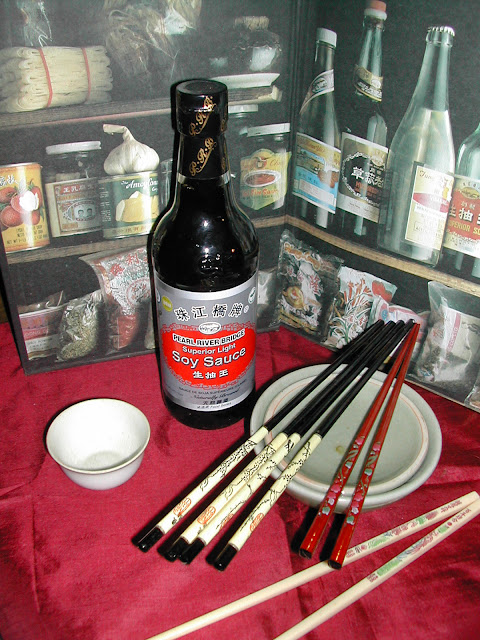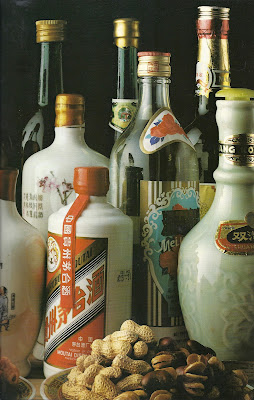Chinese New Year - February 2011
The Year of the Rabbit
*
Chinese New Year is the longest and most important festivity
in the Chinese Lunisolar Calendar.
The origin of Chinese New Year is itself centuries old and gains
significance because of several myths and traditions.
Ancient Chinese New Year is a reflection on how
the people behaved and what they believed in the most.
Chinese New Year is celebrated in countries and territories
with significant Chinese populations,
such as Mainland China, Hong Kong, Indonesia, and.........
and also in Chinatowns elsewhere.
*
Fortune god
*
On the days before the New Year celebration Chinese families give their
home a thorough cleaning. There is a Cantonese saying
"Wash away the dirt on ninyabaat"
It is believed the cleaning sweeps away the bad luck of the preceding year
and makes their homes ready for good luck.
Brooms and dust pans are put away.
Some people give their homes, doors and window-frames a new coat of red paint.
Homes are often decorated with paper cutouts of
Chinese auspicious phrases and couplets. Purchasing new clothing,
shoes, and receiving a hair-cut also symbolize a fresh start.
*
At the Chinese New Year red is important.
People wear red clothes, they write poems on red paper,
and give children 'luck money' in red envelopes.
The symbolism behind the red color is fire,
and fire burns off bad luck.
As for fireworks one belief is that the cracker jacks
and sparks frighten away evil spirits.
Red is the emblem of joy,
and this color also symbolizes virtue, truth and sincerity.
On the Chinese opera stage, a painted red face usually denotes a sacred
or loyal personage and sometimes a great emperor.
The sound of the Chinese word for "red" is "hong" in Mandarin
which also means "prosperous".
Therefor, red is an auspicious color and has an auspicious sound.
*
*
Locals burn incense to pray for good fortune
on the first day of the Chinese Lunar New Year
at Yonghegong Lama Temple in Beijing, Februar 3, 2011
In Nanjing, Jiangsu Province of China.
*
The Chinese Lunar New Year, also known as the Spring Festival,
which is based on the Lunislar Chinese Calendar,
is celebrated from the first month of the lunar year and ends
with Lantern Festival on the fifteenth day.
These lanterns differ from those of Mid Autumn Festival in general.
They will be red in color and tend to be oval in shape.
these are the traditional Chinese paper lanterns.
Those lanterns, used on the fifteenth day of the Chinese New Year
for the Lantern Festival, are bright, colorful,
and in many different sizes and shapes.
*
New Year in London's 'Chinatown' (a few years ago)
Greetings in Chinese...
*
In 1849, with the discovery of gold and the ensuing California Gold Rush, over 50,000 people had come to San Francisco to seek their fortune or just a better way of life. Among those were many Chinese, who had come to work in the gold mines and on the railroad. By the 1860s, the residents of San Francisco's Chinatown were eager to share their culture with their fellow San Francisco residents who may have been unfamiliar with (or hostile towards it). The organizers chose to showcase their culture by using a favorite American tradition - the parade. Nothing like it had ever been done in their native China. They invited a variety of other groups from the city to participate, and they marched down what today are Grant Avenue and Kearny Street carrying colourful flags, banners, lanterns, and drums and firecrackers to drive away evil spirits. The current San Francisco Chinese New Year Festival and Parade traces its line age back to those early parades, and still incorporates Grant and Kearny Streets into its street festival and parade route, respectively.
*
The Legend of the Jade Rabbit
In this legend, three fairy sages transformed themselves into pitiful old mens
and begged for something to eat from a fox, a monkey and a rabbit.
The fox and the monkey both had food to give to the old men,
but the rabbit, empty-handed, offered his own flesh instead,
jumping into a blazing fire to cook himself.
The sages were so touched by the rabbit's sacrifice that they let him live
in the Moon Palace where he became the "Jade Rabbit".
*
*
Here is what I found for The Rabbit in the Chinese zodiac:
People born under the sign of the rabbit are traditionally thought to be gentle, sensitive, modest, merciful and have a strong memory.
They like to communicate with others in a humorous manner.
They cannot bear dull life, so they are good at creating romantic or interesting situations but they lack meditative abilities and often sink money into ideas that may cause failures in their career.
People born in the Year of the Rabbit are articulate, talented and ambitious.
They are virtuous, reserved, and have excellent taste.
Rabbit people are admired, trusted, and are often financially lucky.
('financially' - is it a contradiction to one of the above?)
They are fond of gossip but are tactful and generally kind.
Rabbit people seldom lose their temper.
They are clever at business and being conscientious, never back out of a contract.
They would make good gamblers for they have the uncanny gift of choosing the right thing. However, they seldom gamble, as they are conservative and wise.
So, if You are a Rabbit according to the Chinese horoscope,
what do you think about all that?
Chinese sign for the Rabbit
*
We celebrate......
.....with....
TRESUREPRESS
*
Wherever you go, go with your heart.
Confucius
HAPPY NEW YEAR TO CHINA !





















This was enlightening and delightful post, I think I am inspired to celebrate at my house! I could use some warm sake in this cold weather anyway..... Andsome bunny ears....Maryanne ;)
ReplyDeleteI did not know all of their traditions, how very interesting! It's always fascinating to learn another's traditions. Wonderful post!
ReplyDelete